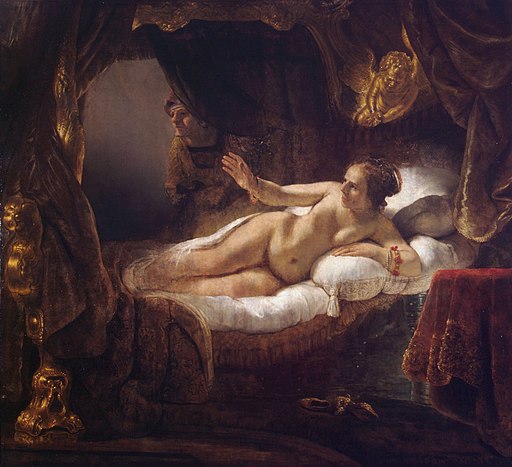
The original painter of light, Rembrandt van Rijn was born on July 15, 1606 in Leiden, Netherlands. He is one of the most imitated painters in terms of brushwork, although his particular use of chiaroscuro is truly unique and personal. His etchings are also what make him one of the greatest in that genre, producing an enormous amount in his lifetime, and lastly, his self-portraits are among the most famous of any artist in history for their sincerity and penetrative insight. Of the many he painted the example above is one of his finest, in my opinion, for its execution and presence: he was 34 years old, towards the peak of his success. Years ago I watched the film of his life made in 1936 by Charles Laughton, and is still the best film I've seen on an artist to date. Laughton was perfect for the role.

Danaë, ca.1636-47
Rembrandt's interpretation of this often painted mythological scene is intimate and real, and Danaë's body language is what makes this painting so spontaneous. Zeus appears to her in the form of a shower of gold and impregnates her, yet here we only see her reaching out with one arm, waiting to be showered. The soft white cushions reinforce her warm skin and the light spilling on her, yet also makes a sort of diagonal space amidst the warm darks of the room. Notice how the drapery surrounds her in such a way to lead the eye around her body while minimizing the details of the room itself. Rembrandt's wife Saskia was the model for the painting but apparently he changed the face to mimic his lover, Geertje. This is a painting to see in person at the Hermitage: it measures eight by ten feet!

Portrait of van Haesje v.Cleyburg, 1634
A more tightly rendered portrait that shows Rembrandt's skills at evoking character and paying great attention to skin tones and facial details. It is a timeless portrait. Bathed again in light, notice not only the dark background but the soft shadow behind her neck.

Old man with turban, ca.1625
click here for zoomable version
Again, Rembrandt's genius was simplicity and creating atmosphere and character from the ordinary. However, look more closely and you see how his use of contrast makes this painting: the robe the man wears is mere brushstrokes, yet compare with the intricate golden details of the turban. Rembrandt gives this man a pensive face, lost in his own world. This interesting sidelight serves to focus on the turban and not the man, yet he is more intriguing with his face in the subtle shadows. Note how the background is illuminated in warmly but the atmosphere is created by very soft shadow edges. This is what makes Rembrandt the painter of light, (not Thomas Kincaid!!).

The Risen Christ Appearing to Mary Magdalen, 1638
An absolutely breathtaking display of Rembrandt's powers of chiaroscuro and atmosphere. Mary asks a bystander at the tomb of Christ about the open grave and gasps when he calls her name...all bathed in Rembrandt's favourite use of deep warm palette to heighten the drama. What he may have lacked in terms the of anatomy and facial expressions of his contemporaries Rembrandt more than compensates with a sense of presence like no one else could paint. A great inspiration for all of us: take your greatest strength and run with it, don't fret over any weaknesses you might have. Here however, Rembrandt does experiment with perspective with strong diagonals and verticals.

An Old Man in Red,ca.1652-54
In his more mature style Rembrandt develops his taste for palpable texture and a fascination with aging skin, especially in his own self-portraits. His portraiture only gets better with time. Again, simplicity and pureness of expression is all that is needed. The use of color seems to recall Titian, but the definition of character is solely Rembrandt. Where Van Dyck captured the person completely, Rembrandt seizes their character by the use of texture and light to tell the story. This use of light has not only inspired generations of painters but would have an enormous impact on photography nearly three centuries later, coining the term Rembrandt Lighting.
Comments
Post a Comment